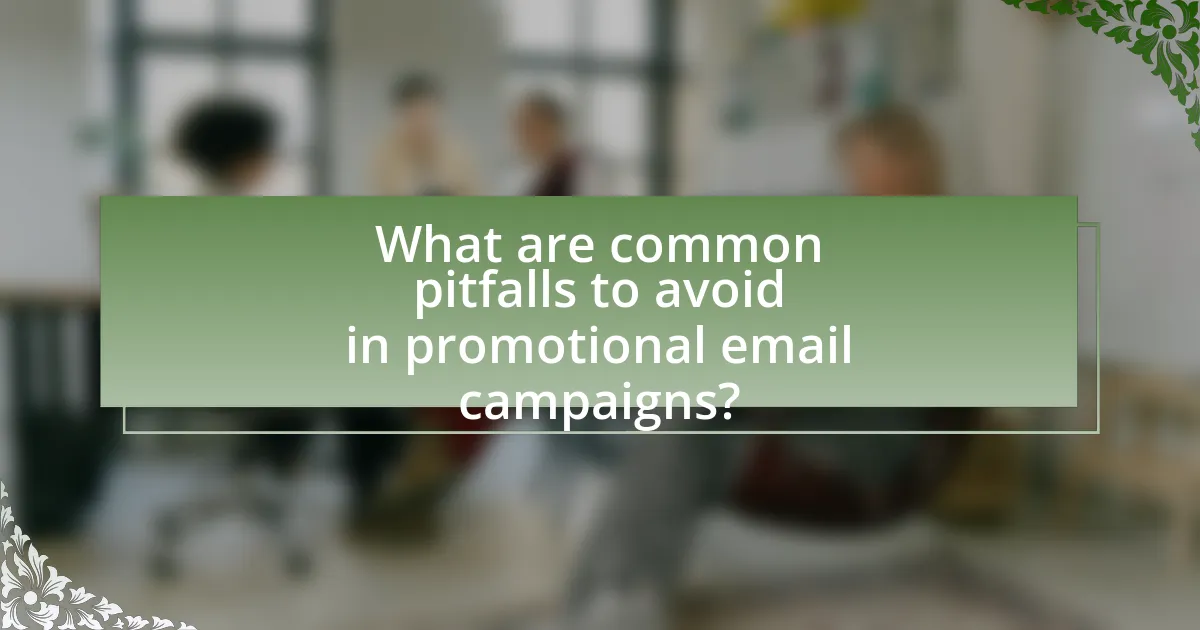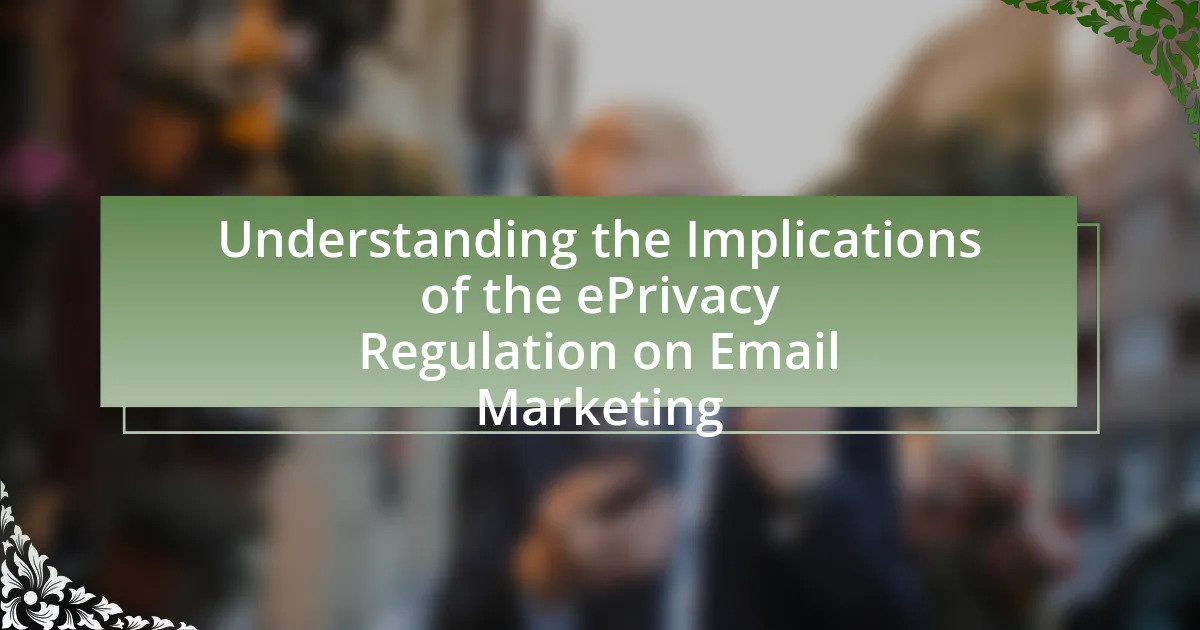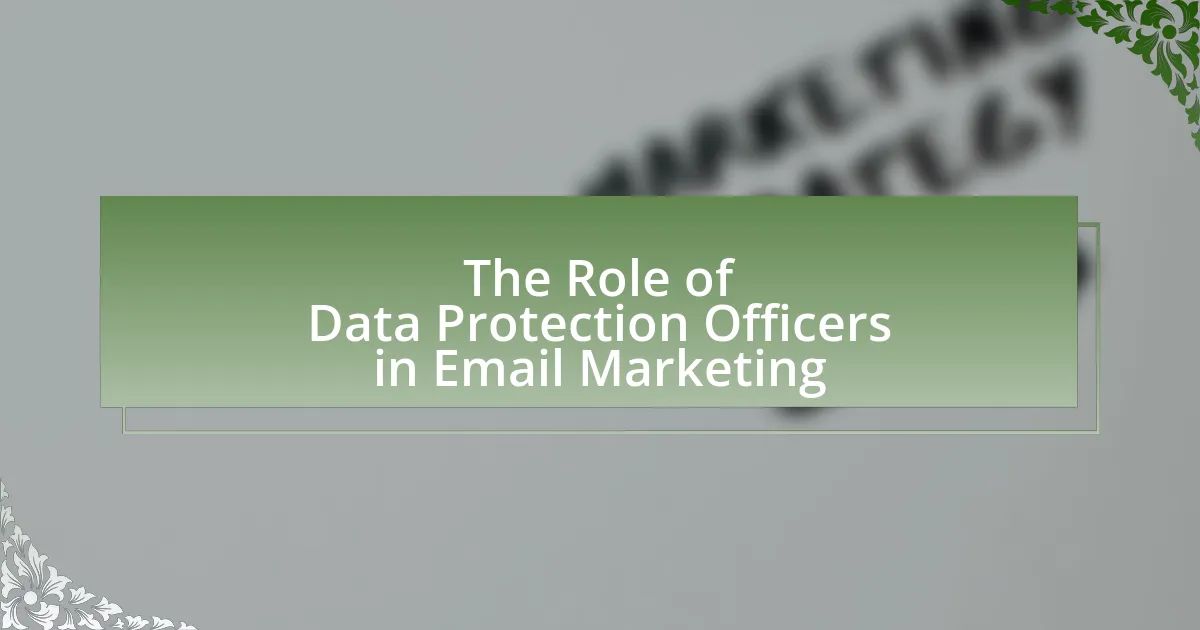The article focuses on the essential elements for crafting compliant promotional emails, emphasizing the importance of obtaining explicit consent, providing clear sender identification, and including an easy opt-out mechanism. It outlines the impact of regulations such as the CAN-SPAM Act and GDPR on email content and marketing strategies, detailing specific laws that govern compliance across different regions. Additionally, the article discusses best practices for email list management, the significance of consent, and the consequences of non-compliance, while offering insights into effective email design and performance metrics. By adhering to these guidelines, businesses can enhance their email marketing effectiveness while ensuring legal compliance.

What are the key elements of compliant promotional emails?
The key elements of compliant promotional emails include obtaining explicit consent from recipients, providing clear identification of the sender, including a valid physical address, and offering an easy opt-out mechanism. These elements ensure adherence to regulations such as the CAN-SPAM Act and GDPR, which mandate that recipients must have opted in to receive communications, know who is contacting them, and have the ability to unsubscribe easily. Compliance with these regulations not only protects consumers but also enhances the credibility and effectiveness of email marketing campaigns.
How do regulations impact promotional email content?
Regulations significantly impact promotional email content by establishing legal requirements that marketers must follow to ensure compliance. For instance, the CAN-SPAM Act in the United States mandates that promotional emails must include a clear opt-out mechanism, accurate sender information, and a truthful subject line. Failure to adhere to these regulations can result in substantial fines, with penalties reaching up to $43,280 per violation. Additionally, the General Data Protection Regulation (GDPR) in the European Union requires explicit consent from recipients before sending promotional emails, further shaping the content and approach marketers must take. These regulations not only dictate the structure and transparency of promotional emails but also influence the overall strategy for engaging with consumers.
What specific laws govern email marketing compliance?
The specific laws that govern email marketing compliance include the CAN-SPAM Act in the United States, the General Data Protection Regulation (GDPR) in the European Union, and the Privacy and Electronic Communications Regulations (PECR) in the UK. The CAN-SPAM Act mandates that commercial emails must include a clear opt-out mechanism, accurate sender information, and a physical address of the sender. GDPR requires explicit consent from recipients before sending marketing emails and grants individuals the right to access and delete their personal data. PECR complements GDPR by regulating the use of cookies and similar technologies for tracking user behavior in email marketing. These laws collectively ensure that email marketing practices respect consumer privacy and provide transparency in communications.
How do these laws vary by region or country?
Laws governing promotional emails vary significantly by region and country, primarily due to differing regulations on privacy and consent. For instance, the General Data Protection Regulation (GDPR) in the European Union mandates explicit consent from individuals before sending promotional emails, while the CAN-SPAM Act in the United States allows for more lenient opt-out provisions. Additionally, countries like Canada enforce the Canadian Anti-Spam Legislation (CASL), which requires express consent and includes strict penalties for non-compliance. These variations reflect differing cultural attitudes towards privacy and consumer protection, influencing how businesses must approach email marketing in each jurisdiction.
What role does consent play in email marketing?
Consent is essential in email marketing as it ensures that recipients have agreed to receive communications, thereby complying with legal regulations such as the General Data Protection Regulation (GDPR) and the CAN-SPAM Act. These laws mandate that marketers obtain explicit permission from individuals before sending promotional emails, which helps protect consumer privacy and fosters trust. According to a study by the Direct Marketing Association, emails sent to consented recipients have a 50% higher open rate compared to unsolicited emails, demonstrating that consent not only fulfills legal requirements but also enhances engagement and effectiveness in marketing campaigns.
How can businesses obtain proper consent from recipients?
Businesses can obtain proper consent from recipients by implementing clear opt-in mechanisms that require explicit agreement to receive communications. This process involves providing straightforward information about what recipients are consenting to, including the types of messages they will receive and how their data will be used. According to the General Data Protection Regulation (GDPR), consent must be freely given, specific, informed, and unambiguous, which means businesses should avoid pre-checked boxes and ensure that consent is obtained through affirmative action. Additionally, maintaining records of consent and allowing recipients to easily withdraw their consent at any time further supports compliance with legal standards.
What are the consequences of failing to obtain consent?
Failing to obtain consent can lead to legal repercussions, including fines and penalties under laws such as the General Data Protection Regulation (GDPR) and the CAN-SPAM Act. For instance, GDPR violations can result in fines up to 4% of a company’s global annual revenue or €20 million, whichever is higher. Additionally, businesses may face reputational damage, loss of customer trust, and potential lawsuits from individuals whose consent was not obtained. These consequences highlight the importance of adhering to consent requirements in promotional email practices.
What are the best practices for email list management?
The best practices for email list management include regularly cleaning the list, segmenting subscribers, obtaining explicit consent, and providing easy opt-out options. Regularly cleaning the list ensures that inactive or invalid email addresses are removed, which can improve deliverability rates and engagement. Segmenting subscribers allows for targeted messaging, increasing relevance and effectiveness of campaigns. Obtaining explicit consent from subscribers is crucial for compliance with regulations like GDPR and CAN-SPAM, which require clear permission before sending marketing emails. Providing easy opt-out options respects subscriber preferences and helps maintain a positive brand image. These practices are supported by studies showing that segmented campaigns can lead to a 760% increase in revenue, highlighting the importance of effective email list management.
How can businesses ensure their email lists are compliant?
Businesses can ensure their email lists are compliant by obtaining explicit consent from subscribers before adding them to the list. This practice aligns with regulations such as the General Data Protection Regulation (GDPR) and the CAN-SPAM Act, which mandate that individuals must opt-in to receive marketing communications. Additionally, businesses should provide clear information about how subscriber data will be used and allow easy access to unsubscribe options. According to a study by the Direct Marketing Association, 78% of consumers prefer to receive promotional emails from brands they have opted into, highlighting the importance of consent in maintaining compliance and fostering trust.
What strategies can be used to maintain an engaged email list?
To maintain an engaged email list, segmenting the audience based on interests and behaviors is essential. This strategy allows for personalized content delivery, which increases relevance and engagement. According to a study by Mailchimp, segmented campaigns can lead to a 14.31% higher open rate compared to non-segmented campaigns. Additionally, regularly cleaning the email list by removing inactive subscribers helps improve engagement metrics and deliverability rates. Engaging content, such as exclusive offers, surveys, and interactive elements, also fosters a connection with subscribers, encouraging them to remain active.

How can businesses create effective promotional emails?
Businesses can create effective promotional emails by focusing on clear, engaging content, targeted audience segmentation, and compelling calls to action. Clear content ensures that the message is easily understood, while audience segmentation allows businesses to tailor their emails to specific groups, increasing relevance and engagement. Compelling calls to action drive recipients to take the desired action, such as making a purchase or signing up for a newsletter. According to a study by Campaign Monitor, personalized emails can deliver six times higher transaction rates, highlighting the importance of targeting and personalization in promotional email effectiveness.
What are the essential components of a promotional email?
The essential components of a promotional email include a compelling subject line, a personalized greeting, engaging content, a clear call to action, and compliance with legal regulations. A compelling subject line captures the recipient’s attention and encourages them to open the email. Personalization, such as using the recipient’s name, enhances engagement. Engaging content provides value, whether through informative text or appealing visuals. A clear call to action directs the recipient on what to do next, such as clicking a link or making a purchase. Compliance with legal regulations, such as including an unsubscribe option and adhering to data protection laws, ensures the email is legitimate and respects the recipient’s rights. These components collectively enhance the effectiveness of promotional emails and foster positive recipient interactions.
How does subject line impact open rates and compliance?
The subject line significantly impacts open rates and compliance by influencing recipients’ initial perceptions and decisions to engage with an email. A compelling subject line can increase open rates by up to 50%, as it serves as the first point of contact and determines whether the email is perceived as relevant or spam. Additionally, subject lines that clearly convey the email’s purpose and comply with regulations, such as including necessary disclaimers, enhance compliance by ensuring transparency and trust. Research indicates that emails with clear, concise, and compliant subject lines not only achieve higher open rates but also reduce the likelihood of being marked as spam, thereby improving overall email performance.
What content should be included to drive engagement?
To drive engagement in promotional emails, include personalized content that resonates with the recipient’s interests and preferences. Personalization increases open rates by 26%, according to a study by Experian. Additionally, incorporating compelling visuals, clear calls-to-action, and relevant offers can significantly enhance user interaction. Research from HubSpot indicates that emails with engaging visuals can increase click-through rates by up to 42%. Furthermore, segmenting your audience and tailoring content to specific groups ensures that the information is relevant, which can lead to higher engagement levels.
How can design influence the effectiveness of promotional emails?
Design significantly influences the effectiveness of promotional emails by enhancing visual appeal, improving readability, and guiding user engagement. A well-structured design captures attention, with elements such as color, layout, and typography playing crucial roles in conveying the message clearly. Research indicates that emails with a visually appealing design can increase click-through rates by up to 300%, demonstrating the direct correlation between design quality and user interaction. Furthermore, effective use of white space and clear calls-to-action can lead to higher conversion rates, as they help users navigate the content effortlessly. Thus, thoughtful design not only attracts recipients but also drives desired actions, validating its importance in promotional email effectiveness.
What design elements enhance readability and compliance?
Design elements that enhance readability and compliance include clear typography, adequate white space, and a logical layout. Clear typography, characterized by legible fonts and appropriate sizes, ensures that text is easily readable across devices, which is crucial for compliance with accessibility standards. Adequate white space prevents clutter, allowing users to focus on key information without distraction. A logical layout, which organizes content in a hierarchical manner, guides the reader through the email, making it easier to understand and comply with regulatory requirements. These elements collectively contribute to a user-friendly experience that aligns with best practices in email design.
How can mobile optimization affect email performance?
Mobile optimization significantly enhances email performance by improving user engagement and increasing open and click-through rates. Research indicates that over 50% of emails are opened on mobile devices, and emails that are not optimized for mobile can lead to a poor user experience, resulting in higher bounce rates and lower conversion rates. For instance, a study by Litmus found that mobile-optimized emails have a 15% higher click-through rate compared to non-optimized emails. Therefore, ensuring that emails are mobile-friendly is crucial for maximizing their effectiveness and achieving better marketing outcomes.
What metrics should be tracked to measure email success?
To measure email success, key metrics to track include open rates, click-through rates (CTR), conversion rates, bounce rates, and unsubscribe rates. Open rates indicate the percentage of recipients who opened the email, reflecting the effectiveness of the subject line and sender reputation. Click-through rates measure the percentage of recipients who clicked on links within the email, demonstrating engagement and interest in the content. Conversion rates track the percentage of recipients who completed a desired action, such as making a purchase, showcasing the email’s effectiveness in driving sales. Bounce rates indicate the percentage of emails that were not delivered, which can affect sender reputation and future deliverability. Unsubscribe rates reveal the percentage of recipients who opted out, providing insight into content relevance and audience satisfaction. Collectively, these metrics provide a comprehensive view of email performance and areas for improvement.
How can open rates and click-through rates inform future campaigns?
Open rates and click-through rates provide critical insights for optimizing future email campaigns. High open rates indicate effective subject lines and sender recognition, suggesting that similar strategies should be employed in future communications. Conversely, low open rates may signal the need for adjustments in targeting or content relevance. Click-through rates reveal the effectiveness of the email’s content and call-to-action; higher rates suggest that the content resonates with the audience, while lower rates indicate a need for more engaging or relevant material. For instance, a study by Mailchimp found that emails with personalized subject lines had a 26% higher open rate, demonstrating the impact of tailored messaging on engagement. By analyzing these metrics, marketers can refine their strategies, enhance audience targeting, and ultimately improve campaign performance.
What tools can assist in tracking email performance?
Tools that can assist in tracking email performance include Google Analytics, Mailchimp, and HubSpot. Google Analytics allows users to track email campaign performance through UTM parameters, providing insights into traffic and conversions generated from emails. Mailchimp offers built-in analytics that report open rates, click-through rates, and subscriber engagement metrics. HubSpot provides comprehensive email tracking features, including performance analytics and A/B testing capabilities, enabling marketers to optimize their email strategies effectively. These tools are widely recognized in the industry for their ability to deliver actionable insights into email marketing effectiveness.

What are common pitfalls to avoid in promotional email campaigns?
Common pitfalls to avoid in promotional email campaigns include failing to segment your audience, neglecting mobile optimization, and not adhering to legal regulations such as the CAN-SPAM Act. Audience segmentation is crucial because targeted emails yield higher engagement rates; for instance, segmented campaigns can lead to a 760% increase in revenue. Mobile optimization is essential as over 50% of emails are opened on mobile devices, and emails that are not mobile-friendly can result in high bounce rates. Lastly, compliance with legal regulations is mandatory; non-compliance can lead to hefty fines and damage to brand reputation.
What mistakes can lead to non-compliance in email marketing?
Mistakes that can lead to non-compliance in email marketing include failing to obtain explicit consent from recipients, not providing a clear unsubscribe option, and neglecting to include the sender’s physical address. Explicit consent is mandated by regulations such as the General Data Protection Regulation (GDPR) and the CAN-SPAM Act, which require that recipients must opt-in to receive marketing communications. The absence of a clear unsubscribe option violates these regulations, as recipients must have the ability to easily opt-out of future emails. Additionally, omitting the sender’s physical address can result in non-compliance, as it is a requirement under the CAN-SPAM Act to include this information in promotional emails.
How can misleading subject lines affect compliance?
Misleading subject lines can significantly undermine compliance with regulations such as the CAN-SPAM Act, which mandates that email communications must not be deceptive. When subject lines misrepresent the content of the email, they can lead to consumer distrust and increase the likelihood of complaints to regulatory bodies. For instance, a study by the Direct Marketing Association found that 70% of consumers are more likely to report emails as spam if they feel misled by the subject line. This not only damages the sender’s reputation but can also result in legal penalties and fines for non-compliance.
What are the risks of not including an unsubscribe option?
Not including an unsubscribe option poses significant risks, including legal repercussions and damage to brand reputation. Legally, failing to provide an unsubscribe option violates regulations such as the CAN-SPAM Act in the United States, which mandates that all commercial emails must include a clear way for recipients to opt out. Non-compliance can result in fines up to $43,280 per violation. Additionally, from a reputational standpoint, recipients who feel trapped in unwanted communications may report the sender as spam, leading to decreased deliverability rates and potential blacklisting by email service providers. This can severely impact future marketing efforts and customer relationships.
How can businesses handle complaints and unsubscribe requests effectively?
Businesses can handle complaints and unsubscribe requests effectively by implementing a clear and accessible process for customers to voice their concerns and opt-out of communications. This includes providing multiple channels for feedback, such as email, phone, and online forms, ensuring that responses are timely and empathetic. Research indicates that 70% of customers who experience a positive resolution to their complaint will continue to do business with the company, highlighting the importance of effective complaint management. Additionally, businesses should honor unsubscribe requests promptly, as compliance with regulations like the CAN-SPAM Act mandates that unsubscribe options be easy to find and executed within a specified timeframe. By prioritizing customer satisfaction and adhering to legal requirements, businesses can foster trust and maintain positive relationships with their audience.
What processes should be in place for managing complaints?
Effective complaint management processes should include a clear reporting mechanism, timely acknowledgment of complaints, thorough investigation procedures, and resolution protocols. Establishing a dedicated channel for complaints, such as a customer service email or hotline, allows customers to easily express their concerns. Acknowledging receipt of complaints within 24 hours demonstrates responsiveness and builds trust. Investigating complaints involves gathering relevant information and assessing the situation to understand the root cause. Finally, implementing resolution protocols ensures that complaints are addressed effectively, with follow-up communication to confirm customer satisfaction. These processes are essential for maintaining customer relationships and improving service quality.
How can timely responses improve customer relations?
Timely responses significantly enhance customer relations by demonstrating attentiveness and respect for customer needs. When businesses respond quickly to inquiries or issues, they foster a sense of trust and reliability, which can lead to increased customer satisfaction and loyalty. Research indicates that 78% of consumers expect a response within 24 hours, and those who receive prompt replies are more likely to recommend the business to others. This responsiveness not only addresses immediate concerns but also builds a positive brand image, encouraging long-term engagement and repeat business.
What are the best practices for ongoing compliance in email marketing?
The best practices for ongoing compliance in email marketing include obtaining explicit consent from recipients, providing clear opt-out options, and ensuring accurate sender information. Explicit consent is mandated by regulations such as the General Data Protection Regulation (GDPR) and the CAN-SPAM Act, which require marketers to have permission before sending promotional emails. Clear opt-out options must be included in every email, allowing recipients to easily unsubscribe, which is a requirement under the CAN-SPAM Act. Accurate sender information, including a valid physical address, is also necessary to maintain transparency and trust with recipients. Following these practices helps businesses avoid legal penalties and fosters a positive relationship with their audience.
How can regular audits of email practices ensure compliance?
Regular audits of email practices ensure compliance by systematically reviewing adherence to legal regulations and organizational policies. These audits identify potential violations, such as non-compliance with the CAN-SPAM Act or GDPR, which mandate specific requirements for promotional emails. By evaluating email content, consent records, and unsubscribe mechanisms, organizations can rectify issues before they lead to penalties. For instance, a study by the Direct Marketing Association found that companies conducting regular compliance audits reduced their risk of fines by up to 30%. This proactive approach not only mitigates legal risks but also enhances customer trust and engagement.
What resources are available for staying updated on email marketing laws?
To stay updated on email marketing laws, professionals can utilize resources such as the Federal Trade Commission (FTC) website, which provides comprehensive guidelines on the CAN-SPAM Act and other regulations. Additionally, the Email Marketing Association offers insights and updates on best practices and legal compliance. Legal blogs and newsletters, such as those from law firms specializing in digital marketing, also provide timely information on changes in legislation. These resources are essential for ensuring compliance with evolving email marketing laws.



